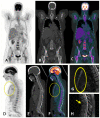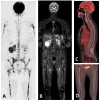Imaging of Multiple Myeloma: Present and Future
- PMID: 38202271
- PMCID: PMC10780302
- DOI: 10.3390/jcm13010264
Imaging of Multiple Myeloma: Present and Future
Abstract
Multiple myeloma (MM) is the second most common adult hematologic malignancy, and early intervention increases survival in asymptomatic high-risk patients. Imaging is crucial for the diagnosis and follow-up of MM, as the detection of bone and bone marrow lesions often dictates the decision to start treatment. Low-dose whole-body computed tomography (CT) is the modality of choice for the initial assessment, and dual-energy CT is a developing technique with the potential for detecting non-lytic marrow infiltration and evaluating the response to treatment. Magnetic resonance imaging (MRI) is more sensitive and specific than 18F-fluorodeoxyglucose positron emission tomography/computed tomography (FDG-PET/CT) for the detection of small focal lesions and diffuse marrow infiltration. However, FDG-PET/CT is recommended as the modality of choice for follow-up. Recently, diffusion-weighted MRI has become a new technique for the quantitative assessment of disease burden and therapy response. Although not widespread, we address current proposals for structured reporting to promote standardization and diminish variations. This review provides an up-to-date overview of MM imaging, indications, advantages, limitations, and recommended reporting of each technique. We also cover the main differential diagnosis and pitfalls and discuss the ongoing controversies and future directions, such as PET-MRI and artificial intelligence.
Keywords: computed tomography; imaging; magnetic resonance imaging; multiple myeloma; positron emission tomography.
Conflict of interest statement
The authors declare no conflict of interest.
Figures














References
-
- Rajkumar S.V., Dimopoulos M.A., Palumbo A., Blade J., Merlini G., Mateos M.-V., Kumar S., Hillengass J., Kastritis E., Richardson P., et al. International Myeloma Working Group Updated Criteria for the Diagnosis of Multiple Myeloma. Lancet Oncol. 2014;15:e538–e548. doi: 10.1016/S1470-2045(14)70442-5. - DOI - PubMed
-
- Dimopoulos M., Terpos E., Comenzo R.L., Tosi P., Beksac M., Sezer O., Siegel D., Lokhorst H., Kumar S., Rajkumar S.V., et al. International Myeloma Working Group Consensus Statement and Guidelines Regarding the Current Role of Imaging Techniques in the Diagnosis and Monitoring of Multiple Myeloma. Leukemia. 2009;23:1545–1556. doi: 10.1038/leu.2009.89. - DOI - PubMed
-
- Facon T., Dimopoulos M.A., Meuleman N., Belch A., Mohty M., Chen W.-M., Kim K., Zamagni E., Rodriguez-Otero P., Renwick W., et al. A Simplified Frailty Scale Predicts Outcomes in Transplant-Ineligible Patients with Newly Diagnosed Multiple Myeloma Treated in the FIRST (MM-020) Trial. Leukemia. 2020;34:224–233. doi: 10.1038/s41375-019-0539-0. - DOI - PMC - PubMed
-
- Palumbo A., Bringhen S., Mateos M.-V., Larocca A., Facon T., Kumar S.K., Offidani M., McCarthy P., Evangelista A., Lonial S., et al. Geriatric Assessment Predicts Survival and Toxicities in Elderly Myeloma Patients: An International Myeloma Working Group Report. Blood. 2015;125:2068–2074. doi: 10.1182/blood-2014-12-615187. - DOI - PMC - PubMed
Publication types
LinkOut - more resources
Full Text Sources

